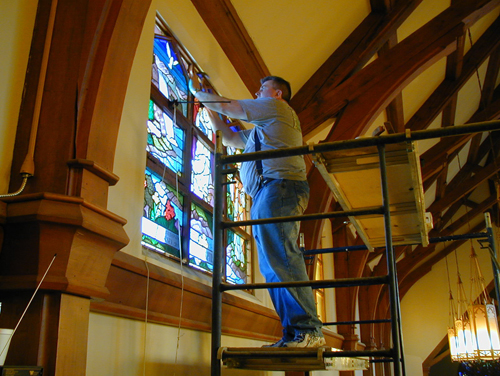A client initializes contact with us usually either by telephone or email. From our initial contact, we glean from the client the approximate size of the window and the proposed subject matter.
We make an appointment with the client and make a site visit. We accurately measure the window and make templates if required. We show the client pictures of windows that we have made prior in order that they can further decide on a subject for the window. We further observe the architecture of the building where the window is to be installed to further ascertain the style of window. If there are stained glass windows already in the building. We try to be as polite as possible and match them as closely as possible in style and treatment.
After subject matter has been determined we proceed to make a customized scale water colour rendering. The design is usually one inch to the square foot. This we show to the client for their final approval. We often times give the client coloured copies of the design which is theirs to keep and distribute to other family members.
When the design has been approved we invoice for a 50% deposit and proceed with the making of a full size working drawing of the window. This drawing is kept in house and enables or glass cutters to make patterns and our glass painters to accurately paint onto the glass.
The glass is then cut. Our glass cutters choose from our hundreds of shades of coloured, antique, hand blown glasses, the glass that is most representative of the colours in the rendering that was shown to our client. Because of our large inventory of glass, we can match these colours exactly. Paper patterns are made using the full size drawing as a template. Paper patterns are placed on the surface of the glass and this assures utmost precision in cutting accuracy.
WE ENCORAGE OUR CLIENTS TO VISIT OUR STUDIO TO SEE THEIR WINDOW BEING MADE
After the glass has been cut, the glass is then sent to the glass painters. The glass is already pre coloured. The glass painters draw lines on the glass to create an image that blocks out the sun, thus creating an image on the glass. There are only a few qualified glass painters in the world today who are fluent in all aspects of glass painting. Our glass painters have apprenticed with our firm and have learned from individuals who have gone on before. All of our glass painters are university graduates in fine arts and have demonstrated the ability and interest to carry on this great tradition. The faces in our windows are second to none. Often times we are called upon to create a face on glass of a famous person or loved one. We use a special lead oxide pigment to paint our glass. The glass is fire in a kiln at approximately 1200 degrees. At that temperature the surface of the glass begins to melt and the paint adheres into the glass permanently. Washing the window with a mild detergent should not remove any of the paint. Flesh glass goes through four different painting and firing processes.
We assemble our windows with our specially made leads. The lead fitter is responsible for choosing the leads that most flatter the design of the window. At this stage the sizing of the window is also checked to assure that it complies with the size of the window into which it is to be installed. The window is soldered with 60/40 solder (60% lead and 40% tin) where the leads intersect both on the front and backside of the window.
After assembly the window is cement back and front with a specially made grouting compound. Grouting compound specially formulated at our studio is forced between the leaf of the lead and the glass. This makes the window waterproof and affords a degree of rigidity to the window.
Our windows are made in sections. One fits on top of another. Between each section is a T bar. The T bar is screwed and inset into the rebate of the opening upon installation. The T bars are fitted with clips to hold the stained glass in place. Intermediary round bars are often added to the windows as well upon installation to assure reliance.
The last process and certainly not least in the production process is installation. Often times we install new stained glass windows in old church frames and older homes. We observe the conditions very carefully in order to verify that the new stained glass can be optimally installed. The old window and stop holding the window in place are removed. The rebate is cleaned very carefully and the opening is checked for square. We start by installing the new panels from the bottom up. After first checking that the window fits properly, sealant is drawn on the rebate and the window attached by nailing through the perimeter lead. The window cannot be installed too tightly as space has to be left for expansion and contraction especially in colder climates. T bars and round bars are installed to provide support for the window. New stop is installed on the interior.
We recommend properly vented exterior tempered glass to provide protection for the window where vandalism could be a problem. Exterior glass also affords thermal protection and assists in preventing heat loss. Our glasses are often installed into a low profile aluminum frame and screwed to the exterior frame. The aluminum frame is electrostatically painted a colour most closely to the exterior colour of the wood frame.
